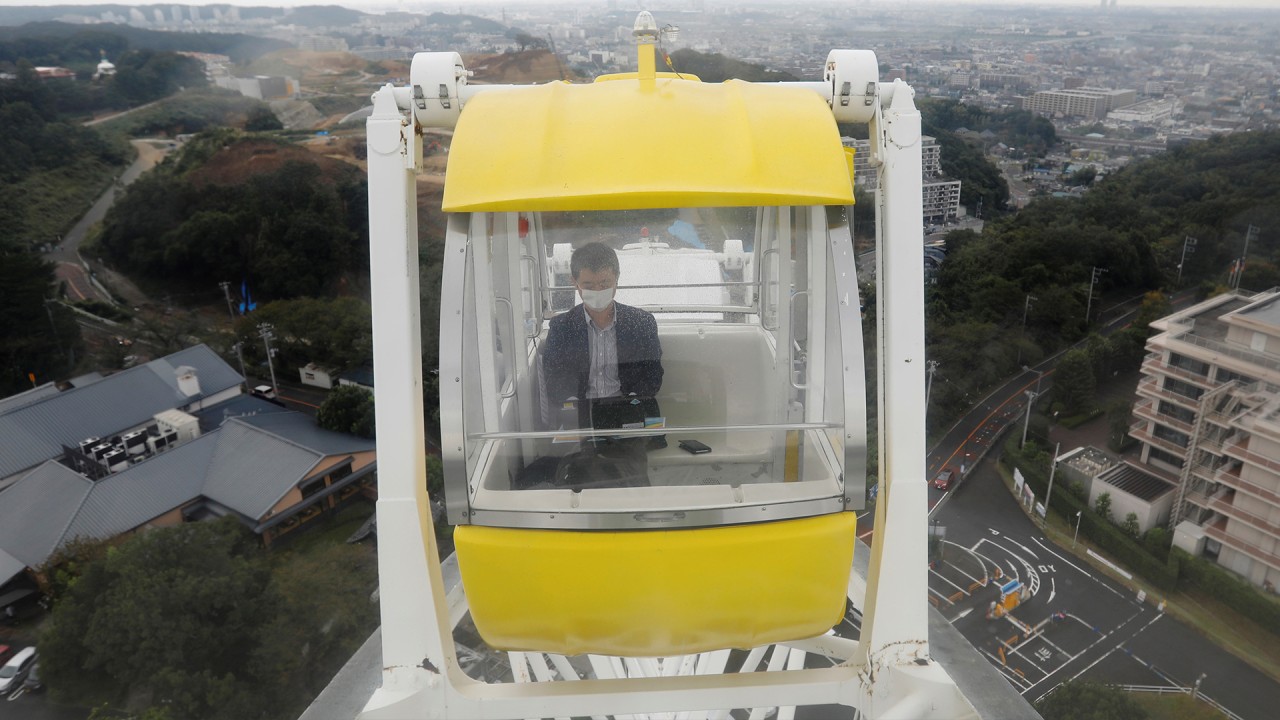
Working from home a low-cost solution to two of China’s biggest problems: low birth rate and high pollution
- The Chinese government has been at pains to increase fertility and reduce pollution
- Raising children in urban China is prohibitively expensive. Telecommuting is a low-cost strategy to address China’s demographic and environmental challenges
Before the pandemic, firms and workers around the world used emails and conference calls to reduce communication costs. But a lack of coordination made it difficult to use these technologies fully.
Firing off an email was easy, but there was no guarantee of when the other person would respond. People were reluctant to break old habits. More broadly, low demand discouraged product development, leaving much to be desired in many workplace apps.

01:24
Japanese theme park opens Ferris wheel for remote workers during coronavirus pandemic
This makes sense: companies lower their real-estate overheads, and employees gain more flexibility in their work schedules and choice of where to live. Moreover, fewer commuters imply less air pollution and urban congestion.
By contrast, in China, many sectors have been able to function relatively normally over the past year. As a result, there has been neither a wholesale shift to virtual work nor much discussion of new workplace models for the post-pandemic era. China risks foregoing benefits to its economy.
For example, virtual technologies can reduce the cost of living for many workers. Raising children in urban China is prohibitively expensive.
In Shanghai, residential real estate costs US$1,453 per square foot in the city centre, on average, but the average annual wage income for a full-time employee is only around US$12,000.

Because the average Chinese primary school student spends 17 hours per week doing homework and six hours per week with tutors, parents need a lot of time to cajole and monitor their children. For many, telecommuting could make all the difference.
In recent years, the government has been at pains to increase fertility and reduce pollution. In 2016, it replaced its one-child policy with a two-child policy for all urban Chinese.
When will Beijing wake up to China’s demographic crisis?
To reduce car usage further, China has invested more than US$1.3 trillion since 2000 in railways to build one of the best urban public transport systems in the world.
Still, these policies have not been enough to offset the rapid increase in urban Chinese who can afford cars and want to drive to work. Between 2000 and 2018, its urban population increased from around 453 million to 824 million.

03:22
Stressed out Chinese man suffers emotional meltdown in public
Promoting virtual workplaces can help address China’s demographic and environmental challenges. The reason for declining fertility is obvious: child rearing is too expensive.
More telecommuting would enable more families to move farther away from the city centre. Parents, freed from commuting, could spend more time with their kids. And reducing the number of commuters would lower air pollution.
Chinese companies that have experimented with telecommuting have found that productivity for some types of work is similar regardless of where it is carried out. And the pandemic has already demonstrated many of the environmental benefits of reduced commuting.
Increased virtual work could be a creative way to address two of China’s biggest problems – declining urban fertility and air quality.
Chinese policymakers and firms should allow more employees to work remotely as much as possible. It is a low-cost strategy that can be implemented flexibly. The potential economic and social benefits could be immense.
Nancy Qian is professor of managerial economics and decision sciences at Northwestern University’s Kellogg School of Management and director of China Lab. Copyright: Project Syndicate

